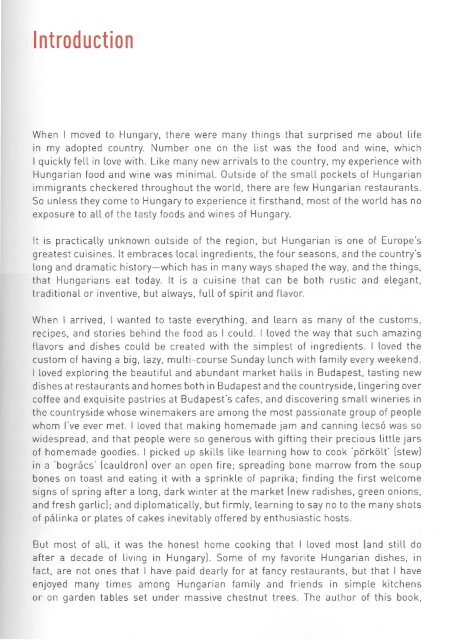Hungarian Cookbook by Tamás Bereznay (2012) - Carolyn Banfalvi
Hungarian Cookbook by Tamás Bereznay (2012) - Carolyn Banfalvi
Hungarian Cookbook by Tamás Bereznay (2012) - Carolyn Banfalvi
Create successful ePaper yourself
Turn your PDF publications into a flip-book with our unique Google optimized e-Paper software.
Introduction<br />
When I moved to Hungary, there were many things that surprised me about life<br />
in my adopted country. Number one on the list was the food and wine. which<br />
I quickly fell in love with. Like many new arrivals to the country, my experience with<br />
<strong>Hungarian</strong> food and wine was minimal. Outside of the small pockets of <strong>Hungarian</strong><br />
immigrants checkered throughout the world, there are few <strong>Hungarian</strong> restaurants.<br />
So unless t hey come to Hungary to experience it firsthand, most of the world has no<br />
exposure to all of the tasty foods and wines of Hungary.<br />
It is practically unknown outside of the reg ion, but Hungar ian is one of Europe"s<br />
greatest cuisines. It embraces local ing redients, the four seasons, and the country"s<br />
long and dramatic history-which has in many ways shaped the way, and the things,<br />
that <strong>Hungarian</strong>s eat today. It is a cuisine that can be both rustic and elegant,<br />
tr aditional or inventive, but always. full of spirit and flavor.<br />
When I arr ived , I w anted to taste everything, and learn as many of the customs,<br />
recipes, and stories behind t he food as I could. I loved the way that such amazing<br />
flavors and dishes could be created with the simplest of ingredients. I loved the<br />
custom of having a big, lazy, multi-cou r se Sunday lunch with family every weekend.<br />
I love d exploring the beautiful and abundant market halls in Budapest, tasting new<br />
dishes at restaurants and homes both in Budapest and the countryside, lingering over<br />
coffee and exquisite pastries at Budapest"s ca fes, and discovering small w ineries in<br />
the count ryside whose w inemakers are among the most passionate group of people<br />
whom l"ve ever met. I loved that making homemade jam and cann ing lecs6 was so<br />
widespread, and that people were so generous with gifting their precious little jars<br />
of homemade goodies. I picked up skil ls like learning how to cook "porkolt" [stew]<br />
in a "bog racs· [ca uldron] over an open fire; spread ing bone marrow from the soup<br />
bones on toast and eating it with a sprinkle of paprika; fi nding the first welcome<br />
signs of spring after a long, dark winter at the market [new radishes, green onions,<br />
and fresh garlic]; and diplomatica lly, but firmly, learning to say no to the many shots<br />
of palinka or plates of cakes inevitably offered <strong>by</strong> enthusiastic hosts.<br />
But most of all, it was the honest home cooking that I loved most [and still do<br />
after a decade of living in Hungary]. Some of my favorite <strong>Hungarian</strong> dishes, in<br />
fact, are not ones that I have paid dearly for at fancy restaurants. but that I have<br />
enjoyed many times among <strong>Hungarian</strong> family and friends in simple kitchens<br />
or on garden tables set under massive chestnut trees. The author of this book,


